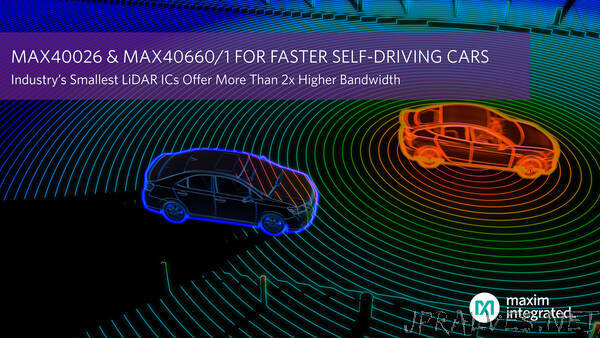
“Tiny, high-bandwidth transimpedance amplifier and high-speed comparator add 32 additional channels to a LiDAR module with the same overall solution size
Designers of automotive self-driving systems can now enable higher-speed autonomous driving through the industry’s fastest and smallest Light Detection and Ranging (LiDAR) ICs from Maxim Integrated Products, Inc. (NASDAQ: MXIM). Compared to the closest competitive solution, the MAX40026 high-speed comparator and the MAX40660/MAX40661 high-bandwidth transimpedance amplifiers enable 10mph (15km/h) faster autonomous driving at highway speeds by providing more than 2x higher bandwidth and accommodating 32 additional channels (128 vs. 96) to a LiDAR module within the same module size.
With automotive self-driving systems evolving from 35mph to 65mph and beyond, LiDAR sensors are playing an increasing role in the fusion of vehicle sensors for their ability to provide accurate distance measurement of objects. With more than twice the bandwidth and the ability to accommodate 33 percent more channels within the same LiDAR module size compared to the closest competitor, the MAX40660/MAX40661 transimpedance amplifiers (TIAs) provide optical receiver designers with higher-resolution images that enable faster autonomous driving systems. The system size of the MAX40026 high-speed comparator plus the MAX40660/1 TIAs is 5mm2 smaller than the closest competitive solution, which allows developers to fit far more channels into space-constrained vehicle platforms. These ICs meet the stringent safety requirements of the automotive industry with AEC-Q100 qualification, enhanced electrostatic discharge (ESD) performance and failure modes, effects and diagnostic analysis (FMEDA) to support ISO 26262 certification at the system level.”
